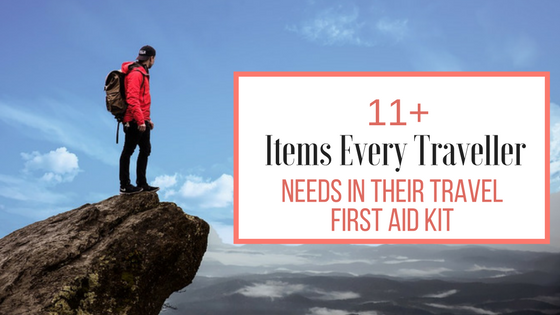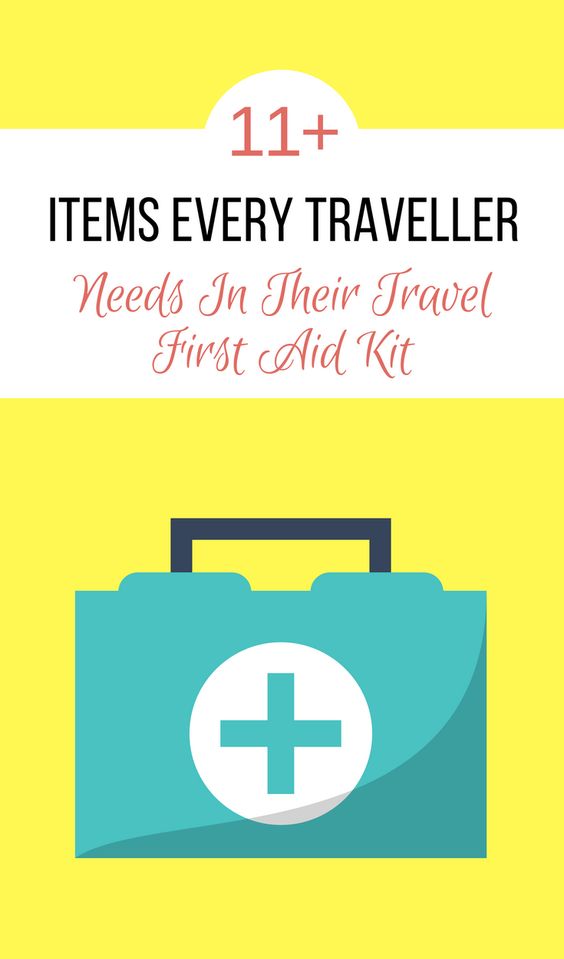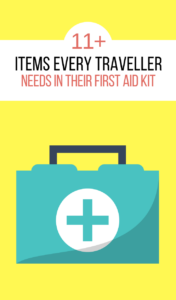11+ Items Every Traveler Needs in Their Travel First Aid Kit

 We are a restless family of four, looking for adventure, ways to increase our funds, and more educaitonal options for our littles. We have exchanged things for experiences. Join us!
We are a restless family of four, looking for adventure, ways to increase our funds, and more educaitonal options for our littles. We have exchanged things for experiences. Join us!We get commissions from the purchases made through the links in this post. See our full disclosure for more details.
A traveling first aid kit is an important item that gets overlooked by many travelers.
When traveling you are far away from the comfort of your own home and the necessities that you are used to having on hand. When you or a little one cuts or scrapes up their knees it’s normal and easy to pop into the bathroom and grab a bandage to patch up the cut, but when you’re on vacation, it’s not so easy.
I don’t know about you, but when I’m traveling I’m actually far more active than I am when at home. I go out on hikes, I walk around entire cities, or explore the waters by snorkeling. This active vacation style can bring more banged up knees and blistered heels then my day to day life.

Related Posts:
Save/Earn 20K+ For Your Next Travel Adventure In 1 Year
Stunning Scottish Adventures to Enjoy With Your Friends
Travel New Zealand for Under $3k

Disclaimer: Make sure that if you haven’t used some of these medications, that you check with your doctor. I’m not a medical professional, but these are just things that, in my opinion, have helped. Also, be sure to keep medications in their original packaging for airport security. If you get hurt on your trip, then be sure to seek out help from a medical professional.
What to put in your travel first aid kit:
Let’s go over the basics first:
Bandages of various sizes and shapes
This should go without saying, but hey I’ll put it here anyway. Cuts and scrapes are going to be the most common pain point and so make sure you have a good variety of bandages for various situations (larger or smaller cuts, cuts on the finger, leg, elbow, etc. They each need different sizes and shapes).
Gauze
Gauze is great to help clean a wound if necessary and it’s also helpful if you need it to cover larger scrapes that the bandage can’t handle. You’ll need to use some tape to keep it on so….
Surgical Tape
Make sure to pack a bit of surgical tape that can be used to keep on gauze for larger cuts.
Small Scissors
Make sure they are small enough that they won’t be confiscated at the airport (under 4 inches long generally). Scissors can be used to help cut up gauze and tape as needed.
Tweezers
Tweezers can be especially useful if you get a sliver or perhaps have some bits of dirt and things in your cut that needs to come out. It’s very important to always clean out dirt from a wound before putting a bandage on it. Yes, these are allowed in most carry-ons, but you may want to double check with the airport regulations first.
Antiseptic wipes
Again, in an effort to keep the wound clean, you will want to wipe it with an antiseptic wipe. It may sting just a bit, but for little, you can pour a little clean water over it and it can help take some sting away.
Pain Relief Medication
This is good in case you get hurt or perhaps find yourself with a headache from overexertion.
Stomach Relief Medication
It’s sad to say that sometimes on vacation we can eat or drink the wrong thing or catch a flu bug if this happens to you, then you will be happy that you thought to bring some medication to help briefly stop diarrhea long enough to get back to a place with a bathroom.
Antihistamines and Cream
If you have any minor allergies, then having some antihistamine on hand can be helpful. As someone with a few allergies (to cats and dust and a few other things), this is truly important.
A good antihistamine cream can come in handy for itchy bug bites or rashes.
Antibacterial Cream
This is just one more way to safeguard against infection.
Condoms
This may not be something you see yourself needing, but either just in case you do or someone you know does, this can be a good thing to have on hand in an emergency.
Additional Options:
RecoverORS Clinical Electrolytes
If you find yourself sick and dehydrated, then this is a great thing to have on hand. This solution was created specifically with travelers in mind to help you rehydrate faster by replacing electrolytes in your body along with clean water. You can find RecoverORS Clinical Electrolytes on Amazon.
Tensor Bandage
This can be helpful when if you sprain a wrist or ankle, which, let’s face it, can happen on a hike or other long walks.
Prescription Medication
If you have prescription medication, then be sure to remember to take them all with you (and maybe use one of those handy weekly pill boxes). Don’t forget your prescriptions and a note from your doctor to show the legitimacy of your medication.
Sunscreen
Most of us go on vacation somewhere with lots of sunshine and so make sure to have this on hand to keep the rays to a minimum.
Latex Gloves
If you are the type to try to help others, then you will want to have some latex gloves on hand to help protect yourself against the transfer of diseases.
Documentations:
This may be a great place to keep your documentation on hand. Here is a list of the documents you may want on hand:
- Proof of insurance coverage
- Immunization card
- Photocopy of all your IDs (passport, driver’s license, health card)
- Name, address, and number of a family member or friend
- Name and phone number of your doctor
- Business card of your most recent accommodations
- Address and phone number of your closest embassy
- Number from your travel health insurance provider
- Information about any allergies you have (especially medication related)
Now that you have your list, make sure you customize it to what you need in your travel first aid kit. But be sure to have some of these things on hand. It will make your trip better and safer.
Am I missing anything that you would put in your travel first aid kit? Comment below!

